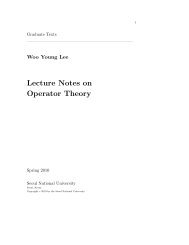Categorification of Donaldson-Thomas invariants via perverse ...
Categorification of Donaldson-Thomas invariants via perverse ...
Categorification of Donaldson-Thomas invariants via perverse ...
You also want an ePaper? Increase the reach of your titles
YUMPU automatically turns print PDFs into web optimized ePapers that Google loves.
8 YOUNG-HOON KIEM AND JUN LIThis is a cubic polynomial in a whose quadratic part isCS 2 ( ¯∂ + a) = 14π∫Y2 tr ( 12 ( ¯∂a) ∧ a ) ∧ Ω.Since the directional derivative <strong>of</strong> CS at ∂ + a in the direction <strong>of</strong> b isδ CS(∂ + a)(b) = 14π∫Y2 tr(b ∧ F ¯∂+a 0,2 ) ∧ Ω,δ CS(∂ + a) = 0 if and only if ∂ + a is integrable. Thus the complex analyticsubspace A intsi <strong>of</strong> simple integrable smooth semiconnections in A si is the criticallocus (complex analytic subspace) <strong>of</strong> CS. Let V si = A intsi /G ⊂ B si. Since CS isG-equivariant, it descends tocs : B si → Cwhose critical locus (complex analytic subspace) in B si is V si .3.2. The universal family over X. Let X ⊂ V si ⊂ B be an open complexanalytic subspace and denote by X = X red the X set endowed with the reducedscheme structure. We assume that X is quasi-projective and that there is a universalfamily <strong>of</strong> holomorphic bundles E over X×Y that induces the morphism X → B. Ourconvention is that E is with its holomorphic structure ∂ X implicitly understood.For x ∈ X, we denote by E x = E| x×Y , the holomorphic bundle associated withx ∈ X. We denote by ∂ x the restriction <strong>of</strong> ∂ X to E x . We use adE x to denote thesmooth vector bundle E ∨ x ⊗ E x .We fix a hermitian metric h on E that is analytic in X direction (see §4.3). For x ∈X, we denote by h x the restriction <strong>of</strong> h to E x . Using h x , we form Ω 0,k (adE x ) s , thespace <strong>of</strong> L l s adE x -valued (0, k)-forms. We form the space A x <strong>of</strong> L l s semiconnectionson E x , which is isomorphic to Ω 0,1 (adE x ) s <strong>via</strong> ∂ x +· (cf. (3.1)). We form the adjoint∂ ∗ x <strong>of</strong> ∂ x using the hermitian metric h x .Since Aut(E x ) = C ∗ , a standard argument in gauge theory shows that the tangentspace <strong>of</strong> B at x is(3.2) T x B ∼ = Ω 0,1 (adE x ) s / Im(∂ x ) s∼ = ker(∂∗x) s , x ∈ X,where the first isomorphism depends on a choice <strong>of</strong> smooth E x∼ = E; the secondisomorphism is canonical using the Hodge theory <strong>of</strong> (E x , ∂ x , h x ). (We use the subscript“s” to indicate that it is the image in Ω 0,1 (adE x ) s .) For any open subsetU ⊂ X, we denote T U B = T B| U . Since X ⊂ B is a complex analytic subspace, it isa holomorphic Banach bundle over U.For x ∈ X, we form the Laplacianand its truncated eigenspace□ x = ∂ x ∂ ∗ x + ∂ ∗ x∂ x : Ω 0,1 (adE x ) s → Ω 0,1 (adE x ) s−2 ,Θ x (ɛ) = C-span {a ∈ Ω 0,1 (adE x ) s | ∂ ∗ xa = 0, □ x a = λa, λ < ɛ} ⊂ ker(∂ ∗ x) s .Note that T x X ∼ = ker(□ x ) 0,1s ⊂ Θ x (ɛ) for any ɛ > 0; since (E x , ∂ x , h x ) are smooth,Θ x (ɛ) ⊂ Ω 0,1 (adE x ) (i.e., consisting <strong>of</strong> smooth forms).













